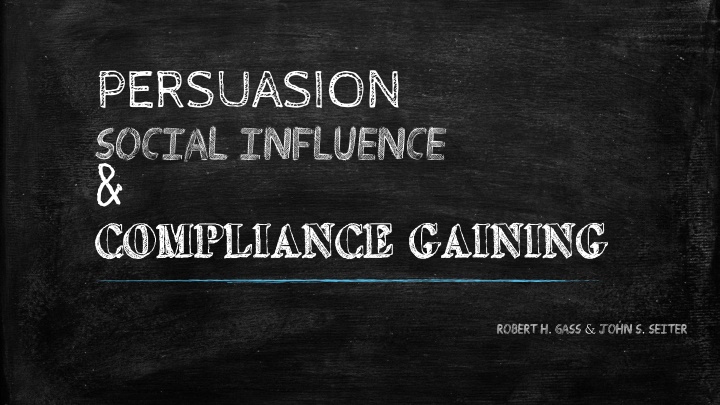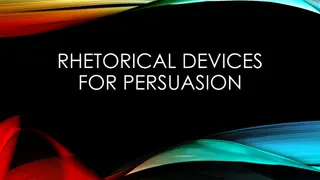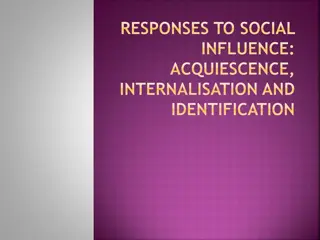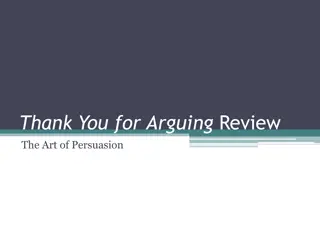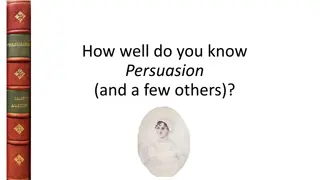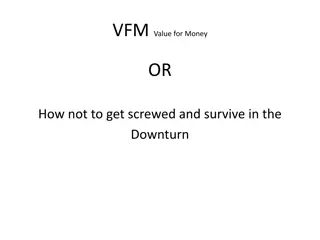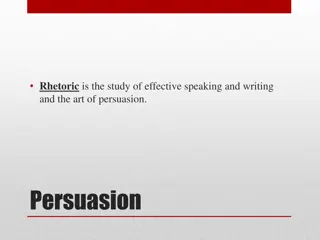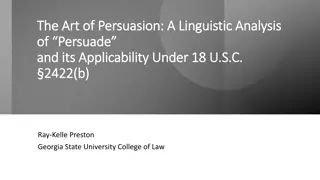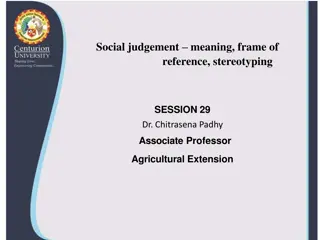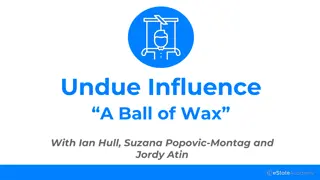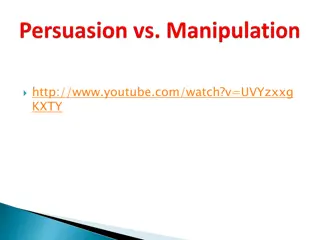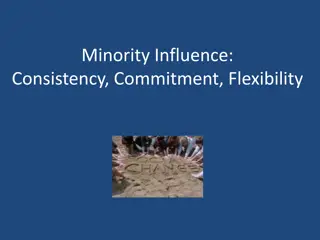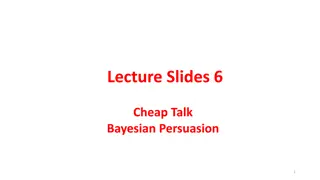Strategies for Effective Social Influence and Compliance in Persuasion
In "Persuasion, Social Influence & Compliance Gaining" by Robert H. Gass and John S. Seiter, Chapter 11 explores sequential persuasion tactics such as pregiving and the foot-in-the-door technique. Pregiving, where favors or gifts create a sense of indebtedness, is effective due to factors like liking, physical attraction, and reciprocity norms. The foot-in-the-door method capitalizes on initial small requests leading to larger compliance. Understanding strategies like these can enhance one's ability to influence others effectively.
Download Presentation

Please find below an Image/Link to download the presentation.
The content on the website is provided AS IS for your information and personal use only. It may not be sold, licensed, or shared on other websites without obtaining consent from the author.If you encounter any issues during the download, it is possible that the publisher has removed the file from their server.
You are allowed to download the files provided on this website for personal or commercial use, subject to the condition that they are used lawfully. All files are the property of their respective owners.
The content on the website is provided AS IS for your information and personal use only. It may not be sold, licensed, or shared on other websites without obtaining consent from the author.
E N D
Presentation Transcript
PERSUASION SOCIAL INFLUENCE & COMPLIANCE GAINING Robert H. Gass & John S. Seiter
CHAPTER 11 Sequential Persuasion
PREGIVING Favors and gifts create a sense of indebtedness. Explanations for pregiving s effectiveness Liking Physical attraction Perceived ulterior motives Gratitude Impression management Internalized social norm; norm of reciprocity Returning favors is culturally universal. Beware of unfair exchanges. example: a male buys a female three drinks in a bar. Does she owe him anything in return?
PREGIVING EXAMPLES Befriending your neighbor Ned fixes Earl s sprinkler, then asks to borrow Earl s lawnmower. Pregiving in sales A company gives important clients free tickets to a ball game. Wedding and baby showers Obligation to give an equivalent gift social exchange theory Political favors Campaign contributions buy access to a politician, if not votes. Panhandling tour guides Panhandlers volunteer directions to tourists, then ask for a tip.
FOOT IN THE DOOR A person who agrees to a small, initial request is more likely to comply with a subsequent larger request. Freedman & Fraser s (1966) classic study initial request: housewives were asked to display a small sign in their window that read Be a safe driver. follow-up request: housewives were later asked to display a large billboard that read Drive Carefully in the front yard. results: 17% of the control housewives complied, compared to 76% of the FITD housewives. Inked Pixels/Shutterstock.com
FITD EXPLANATIONS Bem s self-perception theory: People make self- attributions based on their own behavior. Gorassini & Olson: Self perception is not the only explanation for the FITD. The requestee may consider whether others would reject the request. activating relevant attitudes is important ( you are so thoughtful. You are so generous. )
KEYS TO THE FITD STRATEGY Size of the 1st request Must be small enough to ensure compliance, but not so small as to appear trivial. Prosocial requests The strategy works best with prosocial causes. External incentives There should be no external inducements such as payment or rewards. Who makes the request The 1st and 2nd requests need not be made by the same requester. Social labeling Positive labels help activate relevant attitudes. Preference for consistency People with a high need for consistency are more susceptible. Self concept clarity People with high self-clarity are more susceptible.
THE DOOR IN THE FACE A person is presented with an initial, large request which she/he is inclined to reject. The person thereby becomes more likely to acquiesce to a second, more reasonable request. Cialdini & Ascani s (1976) study: initial request: college dorm residents were asked to donate one unit of blood every two months for a period of three years. follow-up request: dorm residents were asked to give blood once, the next day. results: compliance for the DITF group was 49%, versus 31% for the control group. sirtravelalot/Shutterstock.com
DITF EXPLANATIONS perceptual contrast effect The 2nd request seems much more reasonable by comparison. legitimacy explanation Concessions imply the request is genuine guilt-based explanation The target feels guilty for not being helpful. self-presentation The target doesn t want to be perceived negatively by others. social responsibility position We comply based on our own, internal standards reciprocal concessions The target perceives he/she is engaged in a bargaining situation.
KEYS TO THE DITF STRATEGY Size of the initial request The 1st request must be large enough to be rejected, but not ludicrous. Who makes the request The 1st and 2nd requests must be made by the same requester. Type of Compliance Sought The strategy works best with prosocial causes. Size of the follow-up request The 2nd request must be unambiguously smaller than the 1st. No Time Delay The 2nd request must follow right after the 1st.
SWEETENING THE DEAL But wait, there s more The that s not all strategy sweetens the deal. Free extras add perceived value to an offer. Order now, and I ll throw in Often combined with the scarcity principle. The first 20 callers will also receive Effectiveness is based on reciprocity and contrasting But wait! There s more
THE LOW BALL TECHNIQUE The low ball technique Lowballing involves making an offer that sounds too good to be true. There are, however, hidden strings attached. Once the consumer is psychologically committed, it is hard to back out. zero down car sales A credit card has a low interest rate, but only for a few months. fine print in a low airfare ad ( restrictions may apply ) Effectiveness is based on psychological commitment and unfulfilled obligations pongsakorn chaina/Shutterstock.com; Francois Poirier/Shutterstock.com
BAIT & SWITCH TECHNIQUE Bait & Switch An offer is made that seems too good to be true. When the consumer tries to buy the low-priced item, the item is no longer available. A different, more expensive item is offered instead Sorry, we re out of your size, but That model is actually a piece of junk. For just a bit more, you can get Would you like to upgrade that ticket? nuvolanevicata/Shutterstock.com
OTHER STRATEGIES Disrupt-then-reframe: It s only 500 pennies! Pique technique: Can you lend me $1.47? Legitimizing paltry contributions: Even a penny will help. Evoking freedom: Feel free to say no zimmytws/Shutterstock.com Fear-then-relief: riding an emotional roller coaster
